
by Dharam CW2 | Jul 24, 2023 | General
Delivering a successful project is challenging, especially when there are multiple stakeholders. However, even if a project is performed on time, on budget, and to the expected scope, it can still be regarded as a success only if the stakeholder expectations are managed appropriately.
Each project stakeholder has certain expectations. Project managers are at the forefront of potentially disastrous situations when such expectations conflict. They must address and resolve the issue or risk jeopardizing the project and their position. Because the fundamental cause of problems is only sometimes apparent, project leaders and teams must analyze links between issues and stakeholder motives using interpersonal skills such as resolving conflict, resistance to change, and trust building.

Project Stakeholders
Project Stakeholders
A stakeholder is an individual, group, or organization that is affected by the result of a business venture or project.
Stakeholder interactions may positively or negatively impact the project’s life cycle. Thus, a project leader must identify important stakeholders and develop a stakeholder management plan to satisfy their demands. Using project management tools and strategies to keep track of the key stakeholders is an excellent method to remain on top of things and ensure that project stakeholders remain satisfied and productive.

Types of Stakeholders
Internal Stakeholders
An internal stakeholder is somebody whose interest in the project is directly linked to their affiliation with the entity in charge. Internal stakeholders want the strategic and commercial goals of the project to be realized. They might be project managers, team members, sponsors, owners, or investors.
External Stakeholders
External stakeholders are not directly linked with the company but are important to the business or are influenced by the project in some way. Those are frequently supply chain participants, creditors, or public groups.
Stakeholder Management
The stakeholder management process includes communicating project status, expenses, and barriers to stakeholders to increase visibility, navigate changes in project direction, and manage expectations. Project stakeholders are those involved in the project or whose interests may be influenced by the project’s execution or completion.
Stakeholder management helps project managers keep change at the forefront of their thoughts while making it less intimidating. Furthermore, the stakeholder management plan is a reminder for every interaction the project managers have with direct or indirect stakeholders, helping them maintain a genuine link between the project and day-to-day operations.
Closing the Stakeholder Expectation Gap – Means
An effective stakeholder management process ensures that timely and relevant feedback is provided, and that the stakeholder management strategy directs the change effort. The project manager maintains stakeholder expectations, resolves conflicts, and identifies and fixes any problems that develop throughout the project. In general, the following are the fundamental parts form the stakeholder management process:

The Necessary Elements For Successful Stakeholder Management
- Managing stakeholder expectations: The project is more likely to succeed when stakeholders’ expectations are actively managed. As a result, to ensure perfect conformance with project goals and expectations and to continue the project management effort, the project manager must continually negotiate and influence the demands of stakeholders.
- Managing stakeholder perception: It is critical for project success to ensure that stakeholders are involved in the project regularly and are kept up to date on the project’s progress. High-level stakeholder perception increases the likelihood that stakeholders will provide the necessary support and the project will be completed as intended.
- Keeping track of stakeholder activity: The project manager is primarily responsible for recording and tracking all stakeholders’ activity. As a result, to secure stakeholder acceptance and project communications plan adherence, the project manager should formally document all contacts with stakeholders and keep records of the project’s outcomes.
- Solving problems and resolving conflicts: To avoid challenges and conflicts, the project manager should address stakeholders’ concerns and identify risks and threats in collaboration with conflict management. By referring to change requests, the project manager can generate solutions.
Understanding the components of the managing stakeholder’s process enables the project manager to engage with stakeholder expectations and demands and build action plans to be used when disputes and challenges emerge. The project manager can utilize the following tools to assess conflicts and challenges, as well as manage stakeholders on an individual and group level:

Tools To Assess Conflicts And Challenges In Managing Stakeholder’s Process
- Issue logs: An issue log is a tool for assessing issues and documenting resolutions. It is a document with a rigid categories structure that allows each issue to be placed in the appropriate category (issue group). The project manager uses problem logs to ensure that each stakeholder understands the project and maintains positive working interactions among all stakeholders, including project team members.
- Change Logs: It is a tool for documenting any changes that occur throughout a project. The project manager uses change logs to track changes and their impact on project goals and deliverables. A change log should be provided to project stakeholders and should include data on changes to risks, uncertainties, costs, and budgets.
A change request for project deliverables may result from the technique for managing and engaging stakeholders. Changes to the stakeholder management approach and registry are also feasible. The method of managing stakeholders allows for evaluating and modifying stakeholder benefits created earlier in the project’s life cycle.
Five pitfalls to address while dealing with the expectations of stakeholders

5 Pitfalls To Address While Dealing With The Expectations Of Stakeholders
- Identify the stakeholders
A project often involves many stakeholders, and it can take time to identify all of them. A stakeholder is a person, a group, an organization, or a set of organizations that are actively involved in or may be affected by the project. Stakeholders can have an impact on a project in a variety of ways.
For example, if a stakeholder is top management in an organization and is not completely committed to a project, it may drastically limit buy-in throughout the business. Founders and C-suites are also stakeholders who can positively or negatively impact a project. Therefore, the identification of stakeholders is a critical step in managing expectations.
- Classifying stakeholders
Effective stakeholder management necessitates a project manager categorizing stakeholders based on their role in project completion. A project manager must determine which stakeholders are supporters and which may be obstacles to the project. It might be challenging to define the types of risks, where and when each risk exists, the impact on the project, or how to build strategies to handle possible risks if stakeholders cannot be classified.
- Mapping expectations
Project managers must resolve possible concerns, keep stakeholders involved and motivated, and finish the project on time. A project manager must have a good understanding of all stakeholders’ expectations. Stakeholder analysis and adequate documentation can be useful in mapping expectations. Stakeholders may have different priorities when completing tasks, milestones, or the full project. Their interests may be interpreted differently and have different definitions of success.
For example, one stakeholder may prioritize project completion on time, while another defines success as keeping it under budget. Mapping expectations and obtaining clarity among all stakeholders enhances the possibility that a project manager and their team can effectively complete a project.
- Using appropriate communication methods
Stakeholder management requires determining and implementing appropriate communication methods. To successfully manage stakeholder expectations, a project manager must establish the available and preferred communication mechanisms for stakeholders. A poor or incorrect communication approach can lead to distrust and dissatisfaction between stakeholders and a project manager. It is also essential to adjust communication tactics and frequency based on elements such as time, message, purpose, secrecy, or changes based on stakeholder contexts.
- Engaging stakeholders
Stakeholder engagement during the project with frequent updates boosts stakeholder confidence, which is essential for project success. In addition, efficient stakeholder management necessitates the involvement of stakeholders in decision-making by the project manager.
Although a project manager may believe they have already determined the optimal course of action, they should incorporate stakeholders in procedures and pertinent talks to ensure all options have been examined; otherwise, key possibilities and expectations may be missed.
Closing the Stakeholder Expectation Gap – Methods
Before beginning a new project, start by identifying all stakeholders. First, identify those impacted by the project and the organizations that will influence the project. Then, using the strategy outlined below, begin developing strong relationships with each stakeholder.

Closing the Stakeholder Expectation Gap – Methods
- Analyze stakeholders
Conduct a stakeholder analysis or an evaluation of the key participants in a project and how the initiative will affect their issues and requirements. Determine their unique qualities and interests. Find out what motivates them and what frustrates them. Define responsibilities and levels of engagement, and assess whether there are any disputes among stakeholders.
- Assess the influence
Determine the extent to which stakeholders can have an impact on the project. The more powerful a stakeholder is, the more a project manager will require assistance. When evaluating stakeholders, consider the question, “What’s in it for them?” Knowing what each stakeholder needs or desires from the project allows the project manager to measure their degree of support. Remember to weigh support against influence, like Is it more necessary to have strong support from a low-level stakeholder or moderate support from a high-level stakeholder?
- Understand their expectations
Determine the exact expectations of stakeholders. Then, when necessary, seek clarification to ensure they are thoroughly understood.
- Define “success”
Every stakeholder may have a distinct definition of project success. Discovering this towards the end of the project is a potential disaster. Instead, gather definitions and integrate them into the objectives to guarantee that all stakeholders support the final results.
- Keep stakeholders involved
- Don’t just provide updates to stakeholders.
- Solicit their opinions.
- Schedule time for brief meetings to get to know them better.
- Determine each stakeholder’s ability to engage while keeping time restrictions in mind.
- Keep stakeholders informed
- Send regular status updates.
- One update each week is generally adequate.
- Hold project meetings as appropriate, but allow enough time between them.
- Respond to stakeholders’ inquiries and emails as soon as possible.
- Regular contact is usually valued – and may help ease the impact when you have unpleasant news to deliver.
These are some of the fundamentals of developing effective stakeholder connections. However, like with any relationship, there are subtleties that every effective project manager knows, such as understanding the distinctions and responding successfully to various types of stakeholders.
Final Thoughts
There is a link between resolving conflicts in stakeholder expectations and project success. Similarly, the faster project teams defuse a potentially dangerous situation by recognizing the source of conflicts, the link between issues, and the motivations of stakeholders, the simpler it is to develop trust, settle conflicts, and overcome resistance to change.
Using diverse modes of communication between the project team, senior management, and stakeholders improves prospects for mutual understanding. These methods may help the project managers to meet the stakeholder expectations and reduce the risk of project disaster.
Feel free to check out my discussion on this topic with Thomas Walenta in YouTube
For any questions related to your Project Management career, training, and certifications, you can book an obligation free 15 minutes session with me by visiting talktodharam.com
You can subscribe to the vCare Project Management YouTube Channel to catch future videos of our Q&A series and certification success stories: https://bit.ly/2YF0wJl
You can subscribe to and follow my podcasts and interviews with Project Management Experts on YouTube at https://bit.ly/2NDY8wd

by DharamCW | Feb 24, 2023 | General
To be successful in project management, professionals must adhere to specific values like honesty, responsibility, respect, and fairness, which are central to the project management profession and are encompassed by ethics in project management. Therefore, understanding these values and how to apply them is essential for working in project management.
Ethics is important in day-to-day interactions and behaviors in the project management world. “Ethics is about making the best possible decisions concerning people, resources, and the environment,” according to the PMI (Project Management Institute). Ethical decisions can reduce risk, advance positive outcomes, build trust, determine long-term success, and build reputations.

Ethical Decisions
Corporate leaders are responsible for ensuring that their employees practice ethics in the workplace. Failing to follow ethics might result in numerous scandals. The project manager must ensure that all projects are managed and executed efficiently and ethically. If a project manager is ethical, they can influence the project team to work ethically and ensure that all project work is done ethically.
PMI has identified four values for ethical behavior in the project management profession, which can be applied amongst project team members to maintain project loyalty and ethics.
Honesty: Be genuine in your communication and behavior
Responsibility: Take responsibility for your decisions and actions and the consequences that result from them.
Respect: Admire yourself, others, and the resources entrusted to you, such as people, money, and reputation.
Fairness: Decisions and actions should be unbiased, and behavior should be free of favoritism, self-interest, and prejudice.
Therefore, project management professionals must follow the Project Management Institute’s (PMI) Code of Ethics to ensure that all decisions taken are in the best interests of stakeholders and the project team.
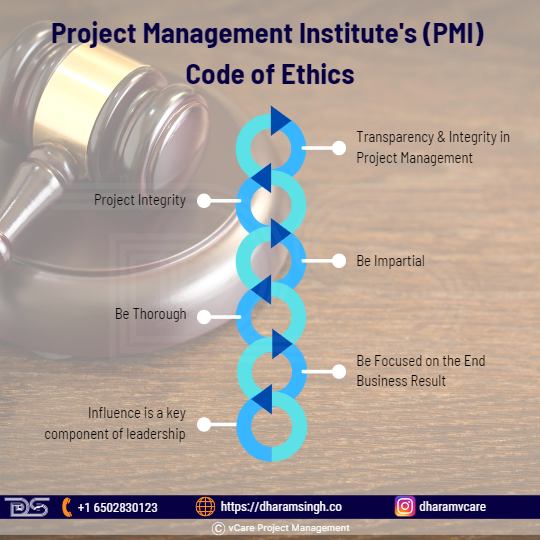
Project Management Institute’s (PMI) Code of Ethics
Transparency & Integrity in Project Management
Project management transparency characterizes a team’s open communication and visibility culture. Information in project management is on a need-to-know basis and is not readily available to everyone. A lack of transparency can lead to resentment or even distrust within the team. Transparency can advance a manager’s career, but it can harm the project manager’s reputation and career if carried out improperly. Therefore, there are many facts to believe that project managers should place a high value on openness and honesty.
The project manager’s transparency can lead to:
- Better performance and accountability
- Eliminates project derailment
- Enhancing teamwork
- Make sure people understand their tasks.
- Communicate openly and explain changes
- Provide and encourage feedback
- Promote knowledge-sharing
- Increase visibility with the right tools
- Focus on project budget
Project Integrity
As a project manager, acting with integrity with other project team members entails being open and honest about their expectations, intentions, and thoughts on their work. In addition, one must have the integrity to make the project team complete the project on time, within budget, and within the project’s scope.
Here are suggestions for acting with integrity with team members:
Be Impartial:
- Be objective and fair.
- Listen to both sides of the tale and different points of view without becoming attached to one in particular due to prejudice or favoritism.
- Rather than patching problems, objective decision-making fleshes them out and allows teams to get to the bottom of them.
Be Thorough:
Complete tasks entirely and thoroughly and validate the steps against a project management methodology of choice. This action ensures that a much more comprehensive project management plan and supporting documentation are created.
Be Focused on the End Business Result:
Regardless of when team members are introduced into the team, they should confirm initial business requirements and the work requested within the scope of their project role. This process enables them to provide their input based on their subject matter expertise, increasing the likelihood of project success.
Influence is a key component of leadership
To influence means to impact other people’s behavior, opinion, and choice. Influence is not the same as power or control. Instead, it is about recognizing what motivates employee commitment and applying that knowledge to boost performance and positive outcomes. The ability to influence others is a necessary leadership trait.
A leader’s ability to influence others is founded on trust; the project manager’s influence grows directly to the level of trust in a relationship. An effective leader motivates team members to act not through coercion but by eliciting their desire and conviction in the leader’s vision and goals. A leader who positively influences others through focused and deliberate effort will gain trust and become a driving force toward excellence.
Let’s look at how leaders can effectively build trust and influence with others.
- Establish credibility
- Engage with team members and build a connection
- Clarify expectations and practice accountability
- Share process knowledge
- Be open to influence
Relationship between stakeholders and project manager to maintain trustworthiness
Communication accounts for up to 90% of a project manager’s job. Conflicts can arise, and projects can fail if there is ineffective communication within the project team. Transparency in the project requires open, two-way communication with stakeholders about the status of a campaign. It keeps clients and stakeholders informed of campaign developments and other project activities.
Why is transparency important for stakeholders?
Transparency is essential in a client-facing project for one simple reason: it fosters trust. When project leader gains the trust of their stakeholders, they are more likely to gain their cooperation and guidance. Maintaining positive stakeholder relationships requires trust, and project stakeholders’ importance cannot be overstated. The support of the stakeholders is critical for project success.
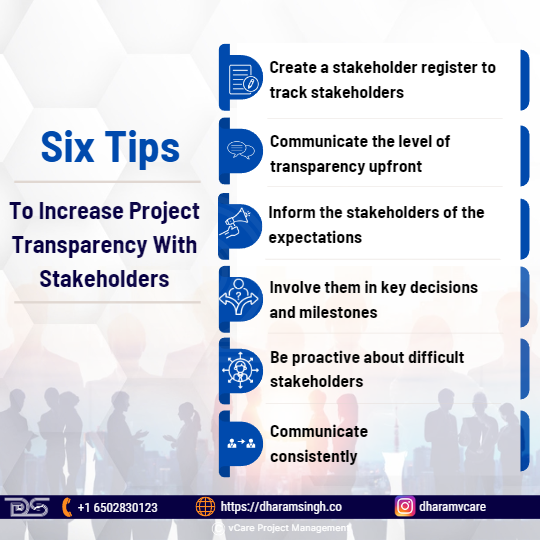
Six Tips To Increase Project Transparency With Stakeholders
Six tips to increase project transparency with stakeholders
- Create a stakeholder register to track stakeholders
- Communicate the level of transparency upfront
- Inform the stakeholders of the expectations.
- Involve them in key decisions and milestones
- Be proactive about difficult stakeholders
- Communicate consistently
Digital Transformation’s Impact on Project Management
Project managers have continued to manage project planning, acquisition, and execution, but their work is evolving with digital transformation.
Most project managers have already incorporated workflow and process automation technology in a few specific areas, like reporting and scheduling. And the majority of them are using digital platforms for project management which can help them stand separate.
How does a project manager acquire the knowledge and experience necessary to lead a digital transformation? What qualities are essential for this type of leader?
PMI’s 2018 Pulse in-depth report ‘Digital PM Skills’ survey conducted by Forrester Consulting for PMI among HR professionals and project managers and identified the top 6 digital-age skills required to get adapted in the digital transformation, like:
- Data science skills
- Innovative mindset
- Security and privacy knowledge
- Legal and regulatory compliance knowledge
- Ability to make data-driven decisions
- Collaborative leadership skills
Cybersecurity’s impact on projects
Project management and the need to establish objectives that protect information security are necessary for today’s project management world. Organizational fragility and vulnerability have increased due to digital transformation, and the proliferation of data and information has become abundant, so it is necessary to safeguard the data from getting misused. Therefore, many businesses are incorporating new elements into their projects to protect their information’s vulnerability, like:
- Security Plan: For the project’s security, a project leader must be aware of the risks to be addressed to develop a security plan. Taking them into account will help them chart the course of the plan and focus on the project’s objectives.
- Business requirements: The project manager must understand the project’s security requirements and business objectives to ensure its completion and success.
- Responsibilities: Each team member should be clear about their responsibilities in terms of security. The well-known RACI (Responsible, Accountable, Consulted, Informed) responsibility assignment matrix is used by many project managers, which aids in ensuring that project objectives are met.
- Security by design: Information security must be considered from the start of a project and throughout the process. Automating processes will improve project success and builds project security.
Pointers to incorporate cybersecurity in project management:
- Determine the project’s sensitive information.
- Evaluate the members’ responsibilities.
- Implement a level of information sensitivity.
- Understand security standards and regulations.
- Include security goals in the project’s objectives.
- Determine the company’s legal responsibilities to the information.
Technology vs. Ethics
Every facet of an organization disrupted by technology shows a possibility of gaining or losing stakeholders’ confidence and commitment. Technology advances can easily outrun the ethical standards that govern their application. Technology’s impact on project ethics is progressing similarly, with employers establishing ethical boundaries that violate employee privacy rights and limit communication abilities.
Some of the technology’s impact on project ethics
- Monitoring Team’s Communications
Project team leaders have monitored employees’ communications during working hours to keep employees focused on work tasks. In addition, because of digital technology and Internet access, there are more chances that project team members can get diverted and utilize the facilities in their personal activities.
The changing definition of the workplace impacts the ethics that underpin the traditional eight-hour work time. It is not ethical simply because technology allows project leader to access their employees and request work at any time. Increasing the working hours to nearly more than their actual hours also blurs the ethical lines in employee compensation.
Employees with restricted access to company property, such as a cell phone or personal computer, may treat it as personal property. An ethical issue may arise when an employee uses office property for non-work-related activities, such as looking for a new job or making personal calls. An employer must establish a clear policy regarding using company property loaned to an employee for business purposes only. This policy enables an employer to develop an ethical standard for using technology.
Ethical Decision Making in Project Management
Decision-making in project management is essentially a great reminder to project success. A truly accomplished project leader inspires, motivates, and builds a strong group that aids their team objectives. The concept of ethical decision-making has also been a focal point in improving project decision-making.
The ethical decision-making process and its roadmap
Every day, a project manager might make thousands of decisions and can come up with the best solution within nanoseconds of hearing about a problem. However, managers must regularly make major decisions incorporating more diligence, forethought, and collaboration with their colleagues. The failure in decision-making can create severe implications and chaos. Thus, organizational performance depends on good decision-making.
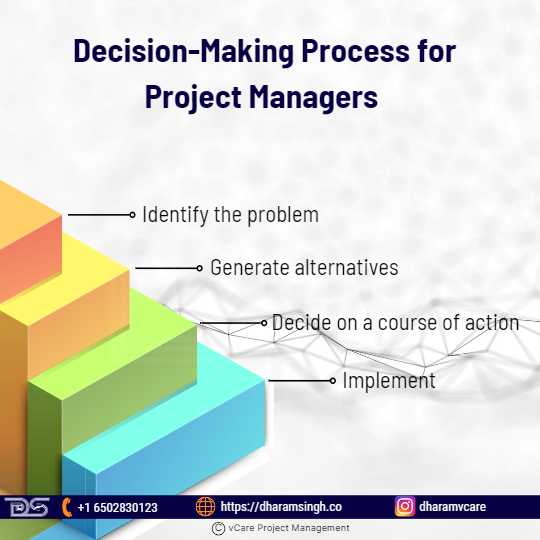
Decision-Making Process for Project Managers
Four steps that can comprise a basic framework for project managers’ decision-making process are:
1) Identify the problem
2) Generate alternatives
3) Decide on a course of action
4) Implement
Ethical Dilemmas in Project Management
The bigger the project, the greater the potential for people or businesses to compromise their moral standards to finish the project on schedule and within budget. The outcomes of project managers and other stakeholders ignoring debatable activity are disastrous, like blown budgets, legal concerns, and even criminal charges, which are too frequent in today’s project environment. Moreover, many businesses are aiming for 100% automation and implementation in the project management process. The project managers need to take charge of these initiatives, which might result in ethical dilemmas involving stakeholders, technology, or communities.
Ethical dilemmas arise when circumstances contradict the project manager’s professional standards or moral values. The project managers must ensure that a project fulfills its social responsibility and well-being commitments by keeping its long-term goals in mind.
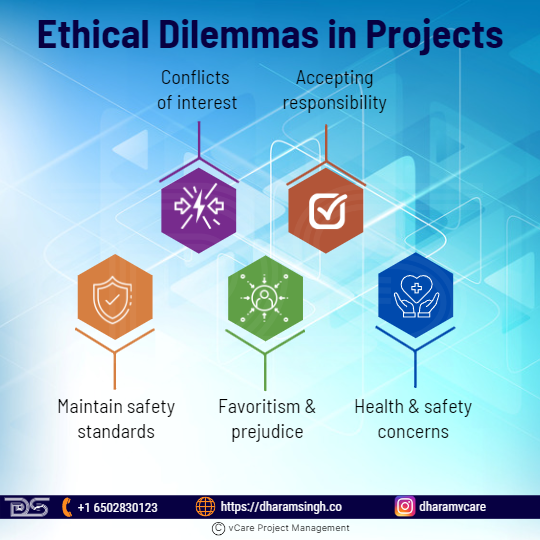
Ethical Dilemmas in Projects
Some Ethical dilemmas in projects include
- Conflicts of interest
For project managers, conflict of interest is a major ethical concern. A conflict of interest occurs only when an individual or group has multiple interests in a project, which may hinder the integrity of the process.
- Accepting responsibility
When a project goes wrong, managers may be tempted to blame workers, supervisors, or vendors for protecting their position. The manager may also consider concealing any evidence that could implicate them in the project’s failure. However, when a project does not go as planned, project managers have an ethical responsibility to accept their failures and start focusing on finding solutions to problems and getting the project back on track.
- Maintain safety standards
Project managers who limit safety standards to save money eventually discover the high costs of not enforcing safety standards with their team. Conversely, a project manager who follows proper safety standards can save a project from incurring costs ranging from minor errors to severe injury or death.
- Favoritism and prejudice
A project leader must not “pick winners” or show bias toward team members. Project managers should choose the participants based on their abilities, not personal preferences. A project manager who shows prejudice toward workers based on race, ethnicity, religion, gender, or other criteria compromises the project’s integrity and exposes the company to a discrimination lawsuit.
- Health and Safety Concerns
Large enterprise projects have high risks and intense deadline pressure. This pressure, unfortunately, can occasionally cause stakeholders to overlook or even hide problems that could endanger the health and safety of project associates or the general public. Although these problems are more likely to occur in the manufacturing, healthcare, or construction sectors, project managers in all sectors should be ready to notify authorities whenever they spot a potentially dangerous situation.
Does project loyalty depend on the individual?
Ethical behavior is essential in all aspects of life, personal and professional. Being an ethical professional benefits everyone, both individually and on a societal and organizational level. Organizations that practice ethics can make their employees optimistic, boost their confidence, and increase their dedication. They can easily draw new clients and consumers due to their honest and ethical behavior, which can significantly improve the project’s sales and profits.
The project manager’s responsibility in Project Management is to manage projects effectively and ethically, as projects are the primary means by which organizations achieve their goals and objectives and develop new services and products. Suppose a new product development project is managed and executed with unethical decisions and actions. In that case, the product will fail to impress and attract customers, resulting in a huge failure and a significant loss in terms of time, project budget, and resources. Customers, clients, and employees value honest and ethical behavior. Thus, a project manager can ideally follow the PMI Code of Ethics and Professional Conduct, which states that they must be honest, respectful, fair, and responsible.
Feel free to check out my discussion on this topic with Thomas Walenta in YouTube
For any questions related to your Project Management career, training, and certifications, you can book an obligation free 15 minutes session with me by visiting http://talktodharam.com/
You can subscribe to the vCare Project Management YouTube Channel to catch future videos of our Q&A series and certification success stories: https://bit.ly/2YF0wJl
You can subscribe to and follow my podcasts and interviews with Project Management Experts on YouTube at https://bit.ly/2NDY8wd

by DharamCW | Dec 21, 2021 | Project-Program-Portfolio Management Knowledge
Project economy is all about people having the skills and capabilities which enable organizations to turn ideas into reality. The key is these projects should deliver financial and societal value through value streams incrementally delivered through projects. The following are the key six factors identified by PMI that influence the projectification in the project economy.
Climate Change
Buildings are being modified, new products are being introduced, new policies and regulations are being applied. Climate factors are one of the biggest factors influencing global projects. Climate central report found that about 300 million people in coastal Asia would be at risk because of rising sea levels by 2050. Apart from this, people worldwide are fighting to manage droughts, flash floods, volcanic eruptions, and raging wildfires. Climatic changes are a global threat, and many young minds are asking for actions from global leaders. This kind of awareness and activism increases action at the ground level, and project leaders are responsible for those actions inducing change.
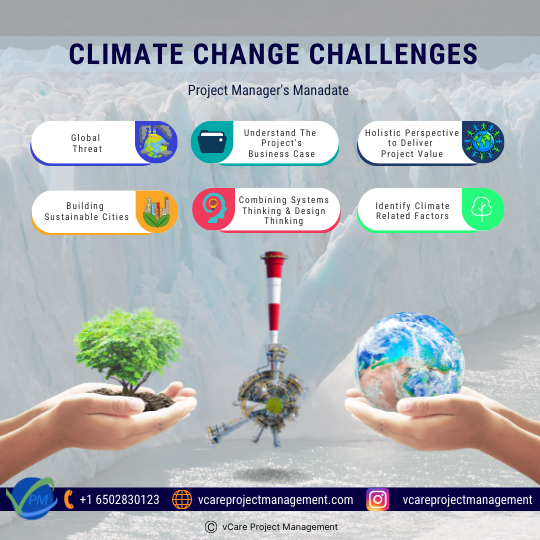
Climate Change Challenges
Infrastructure projects like building sustainable cities can increase green space, manage water risk, etc… These projects directly or indirectly contribute to overall sustainability as well. These complex problems are issues that require a combination of systems and design thinking. The project managers need to respond based on a big picture perspective to manage a complex environment. Nowadays, companies need to have projects on climate projection and sustainability front as a matter of compliance and corporate social responsibility.
The project manager needs to practice agile as these projects change quickly along with technology that changes rapidly. Climate change-related factors influence every sector/industry. The project manager’s mandate is to understand the project’s business case and identify the climate-related factors to deliver project value. Projects, programs, and portfolios have to be aligned to understand this and act with a more creative, front-end-oriented approach for tomorrow’s challenge. Therefore, the role of project managers and program managers is going to impact the future generation.
Artificial Intelligence (AI)
Artificial Intelligence adoption has just begun. The responsibility of appropriate implementation lies with project leaders mitigating societal-related risks, including ethical issues. As healthcare, consulting, and manufacturing industries have started adopting, uncertainty looms at a large adoption and transition. However, tools like RPA and AI have already started contributing to the automation of business processes at large, replacing humans doing monotonous jobs.

Impact of Artificial Intelligence on Project Management
In the recent IPMA and PwC report in October 2020, AI is considered a tool, and it’s more adopted for automation to augmentation and beyond changing the future. According to this report, 56% of the organization already has digital transformation projects, including AI adoption. However, it also highlights that 77% of the project managers don’t have experience in using AI technologies in Project management, indicating that the adoption is still in its early stages. Artificial Intelligence will change project management in Integration, Documentation, Reporting, Forecasting, Budgeting, Resource Allocation, and Predictive analytics.
AI systems can help connect different Enterprise applications, including HR, Task Management Tools, repositories, etc. It can help set intelligent reminders to mitigate risks. AI tools can help in drafting documentation and can help get the data from other systems. AI can also help to organize the documentation for quick recovery through recommendation engines. Task report completion, the status of the work, and milestone tracking can be managed effectively by AI-based reporting. Adopting AI tools can help anticipate the problems early through prognosis with the help of specific indicators.
AI tools can help the project manager by helping with insightful information by analysis of Big Data or real-time stream of data. Decision-making aided by AI can be very useful for the project manager to take decisions or actions in the behavioral areas of people management, including Influence, Negotiation, Motivation, etc… Human touch is a factor that cannot be avoided, and AI can never replace it, yet it can aid. AI adoption in project management can significantly help project managers in Productivity, Decision, and Performance.
Adopting Chatbots can help provide the project’s status, follow-up reports, providing templates, project plan, and status can help human resources work on something much more productive. This initiative will enable project professionals to think more strategically and prepare well-defined, high-level plans. Analysis of the project with the help of statistical or AI models would identify and quantify the risks. This aspect would also help in what-if analysis and validate the certain hypothesis to justify the stakeholders involved. It’s expected the current adoption of AI among project professionals will move from 27% to 35% in the next three years. So, this calls for the project management professionals to invest their time in people skills which will never go away yet understanding the AI paradigm.
Globalization
The business, which is growing at a global scale in terms of people, trade of goods and service, information exchange, has taken an economic toll and countries started showing protectionist measures regarding trade policies, immigration, and work policies. Globalization will impact the future global trade, and countries will focus on inclusive growth to fuel the economy from within. Example(s): BREXIT, US-China Trade issues.
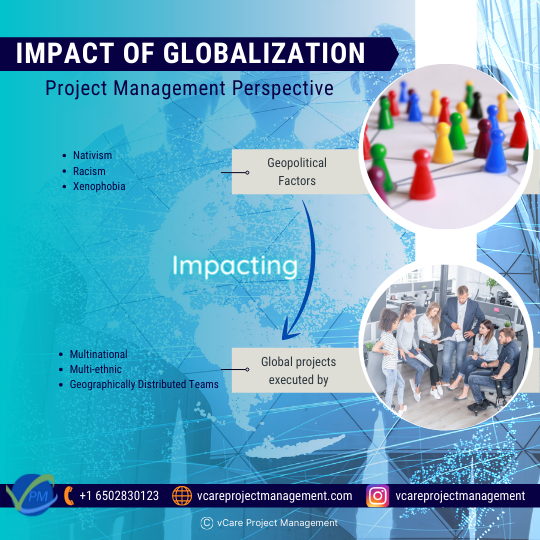
Impact of Globalization | Project Management Perspective
The COVID-19 situation has also added to the existing woes and has impacted global travel and trade. Apart from this, geopolitical factors, including nativism, racism, xenophobia, are impacting global projects executed by multinational, multi-ethnic, and geographically distributed teams. All these challenges are to be managed by the project managers. In addition, the increased volatility of the situation reflecting the business landscape and job market has to be managed by the project managers.
Project managers need to effectively remote work amidst geopolitical situations by collaborating, managing time zones and cultural aspects. Project leaders have to become Virtual Leaders managing lack of commitment, distractions, poor communication, low motivation, etc. This kind of change can be well managed by effective portfolio management driven at the organization level to minimize adverse impact.
Infrastructure Gap
For any investment that is capital intensive, there is a need to understand the data for decision-making. For example, the G20 global infrastructure outlook estimates that US$94 trillion is required by 2040 across 56 countries and seven sectors, but the budget falls short by US$15 trillion. The gaps exist depending on the investment required in this area concerning the current trends, which vary in different demographics.
The project managers and program managers are expected to be smart and agile for cutting costs and helping to expedite the operations faster. The infrastructure investment has been increasing for 3D Printing, Artificial Intelligence, Modularization, Robotics, IoT with Digital Twins for transformation. Singapore is currently working on a project to create a digital twin of the entire city-state.
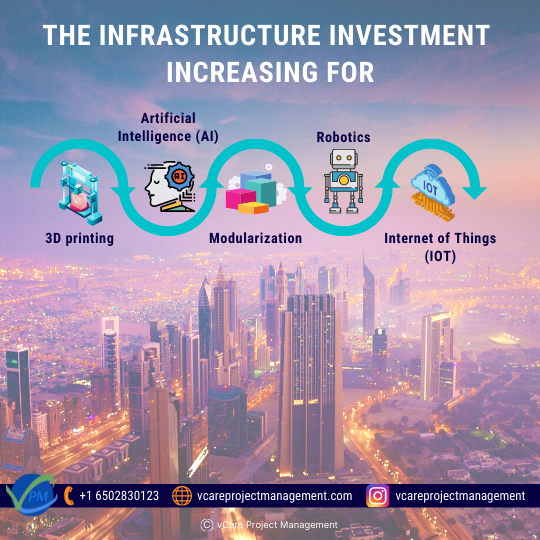
The Infrastructure Investment
The adoption of IoT infrastructure to collect more data is getting more attention. In addition, the advent of technology communication infrastructures such as 4G and 5G has increased cloud data streaming capabilities. As a result, operational efficiency, including an increase in productivity and extending of asset life, could be done only with the help of data and analytics.
Large megaprojects on infrastructure areas such as Dubai Solar Park and the Bridge linking Hong Kong to Macau and Zhuhai have large complexities and challenges posing more risks. It is also about augmenting the capacity required to get on with such mega projects. These projects also need to manage or defend political and financial pressures (Example: Halted 13$ billion airport projects in Mexico) through creative means to meet societal needs. Project managers need to address fiscal prudence and transparency.
Project and program offices also need to attain the balance on leveraging local and global suppliers on Megaprojects. Portfolio managers are finding difficulty in people who have experience managing projects of massive size and complexity. The infrastructure Gap to manage these gaps must be well understood by the project professionals, who must wisely adopt the necessary tools required for these endeavors.
Cybersecurity
According to the PMI signpost 2020 report, US$3.92 million is the average cost of data breaches globally in 2019. As we grow more digital, a push is happening in business, governments, and non-profit on how they operate as they are interdependent. Organizations are managing cybercrime, information warfare, and various threats at all different new levels.

Impact of Cybersecurity on Project Management
Project leaders need to work with cybersecurity teams as the projects are progressing to manage cybersecurity requirements while building solutions. It is essential to understand that classification of information and its sensitivity to manage the threats faced. Non-IT sectors need to gain more awareness in the cybersecurity areas, and it needs to be implemented as an integral part of the organization.
Project managers of the future need to consider the value of data regardless of their domain. They need to understand the importance of understanding data ownership and the potential impact of data loss or breach. Understanding the cost impact of protecting the data assets also has to be counted in the projectification process. Risk management must encompass Cybersecurity as part of it as well.
Shifting Demographics
Key changes are happening in the areas of overall population demographics. The youth population is on the rise, and project managers need to align their leadership styles to suit the target audience more. In addition, the urban landscape is changing globally, and villages are becoming more urbanized with the young population who may lack the necessary experience with the new world. It is also difficult to navigate the projects with them. Also, we need to manage and make the best use of the job market with many young minds available.
Underdeveloped countries are moving across. For example, many projects are going on in African countries building infrastructure for their growth. This expansion would build the future for the people, and these countries willing to participate in the projects for creating a better world would require more understanding at a strategic level.
Feel free to check out my discussion on this topic with Reinhard Wagner in YouTube
You can subscribe and follow my podcasts and interviews with Project Management Experts on YouTube at https://bit.ly/2NDY8wd
You can subscribe to vCare Project Management YouTube Channel to catch future videos of our certification Q&A series and student success stories using the link https://bit.ly/2YF0wJl
For any questions related to Project Management career, training, and certifications, you can book an obligation free 15 minutes session with me by visiting http://talktodharam.com/























Recent Comments